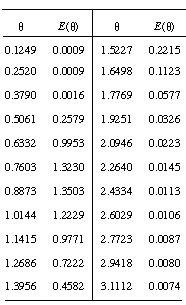Chapter 18: Models for Nonideal Reactors
Additional Homework Problems
CDP18-EB
|
The Chemical Technology Division at Oak Ridge National Laboratory
has developed the use of fluidized beds as bioreactors (ORNL/MIT 319, 1981). Fluidized
beds provide an effective means of promoting contact and hence mass transfer between
the fluid and solid phases. The advantages of these features have been demonstrated
in biological systems for ethanol production and wastewater treatment. For example,
Pseudomonas bacteria adhering to coal particles in a fluidized bed successfully
convert wastewater nitrates to nitrogen gas at 20 to 100 times the rate achieved
in a stirred-tank bioreactor. Although global reaction rates and operating conditions
of fluidized bioreactors have been studied thoroughly, an understanding of their
flow patterns is needed to allow modeling and scale-up. From the exit concentration
data of a typical run, E( (a) The axial dispersion model. |
||
|
|
[2nd Ed. P14-7]
 ), given below, fit the data with:
), given below, fit the data with:
